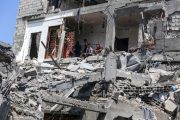
In an interview on October 25, Likud party member and former Knesset lawmaker Moshe Feiglin declared that Israel should pulverize Gaza and expel all Palestinians to Egypt to deter its enemies.
Feiglin’s recent television appearance, in which he urged for leveling Gaza like the German city of Dresden in WWII, has gone viral on social media.
Speaking with the Israel News Network (INN), Feiglin bemoaned that 18 days had passed since the brutal surprise attack by Hamas terrorists on Israelis and “we still have not revenged [sic], in a biblical way … We did not burn Gaza to ashes immediately!”
Israel’s immediate goal must be to “destroy Gaza; above ground and the underground tunnels. Only then send the army in,” Feiglin stated.
“Make sure that all the people of Gaza are running to Rafiah. Create a tremendous humanity crisis. Level the entire area, just as you did in Gush Katif and in Yamit,” Feiglin continued. “Anything less than that, and we’ll be defeated, and we’ll get the same things again and again; even in a worse way.”
Gush Katif was an Israeli settlement inside Gaza destroyed by Ariel Sharon’s government in 2005 as part of Israel’s withdrawal from the territory. Yamit was a settlement in Sinai, bulldozed after a 1982 peace treaty returned that territory to Egypt.
Feiglin slammed Israeli Prime Minister Benjamin Netanyahu’s hesitancy to invade Gaza as having “destroyed Israel” and “destroyed any kind of fear” among the Muslims around the world. Furthermore, he denounced Netanyahu for making Israel into a “banana republic” of the United States.
“The American hug is a bear hug,” Feiglin said. “I respect the Americans. They should not be here. We should not take any assistance from them. I cannot even start to describe what a disaster we are bringing on ourselves, when the only reason why we haven’t reacted in the last 19 days is because of the Americans.”
“The Americans are not coming here because they love our beautiful Jewish eyes. They have their interests, and the minute their interests change, they will be long gone, and we will be stripped from the ability to protect ourselves,” Feiglin elaborated.
Another interview of Feiglin has recently gone viral online. Speaking to Israel’s Channel 14 two weeks ago, he insisted for the “complete incineration” of Gaza, which should “turn into Dresden” with “not a stone on stone” left.
Feiglin is a long-time member of Likud, who contested Netanyahu for party leadership in 2013, obtaining 23 percent of the vote. He was a Likud MK between 2013 and 2015, when he left to start his own movement, but returned to the party in 2021. During the 2014 conflict in Gaza, he submitted a seven-point public proposal to Netanyahu for displacing all Palestinians from the enclave, and did so again in 2018.
The Wall Street Journal (WSJ) also reported on October 25 that Israel has agreed to postpone its planned invasion of Gaza, after the United States asked for time to mobilize naval forces and air defenses around the Middle East.
Washington has convinced Jerusalem to “hold off” Israel’s planned operations until “later this week,” unidentified U.S. and Israeli officials told the newspaper. For its part, the Pentagon has supposedly been “scrambling” to mobilize a dozen or so air-defense systems to bases in Saudi Arabia, the UAE, Kuwait, Iraq, Jordan, and Syria.
Israeli officials told the WSJ that diplomatic efforts to liberate hostages still held by Hamas, and the supply of humanitarian aid to Gaza, were also taken into account by its move to delay its attack on Gaza.
Over the past seven days, drone and rocket strikes have targeted American troops at least 10 times in Iraq and three times in Syria. While the U.S. Central Command (CENTCOM) reported no damage or casualties from the strikes at first, CENTCOM told NBC News on October 24 that the October 18 drone strike on the Al-Tanf outpost in Syria led to 20 troops sustaining “minor injuries.”
Several formerly unknown militias have claimed to be culpable for the strikes. Although the United States has lambasted Iran and its Islamic Revolutionary Guard Corps for “supporting” the militants, it has not supplied any proof of Iranian responsibility.
Since Hamas’ brutal attacks on Israelis on October 7, Israel has been waging war on Hamas, pledging to “dismantle” Hamas and alter the face of Gaza. Jerusalem has since conducted heavy artillery and air strikes against the territory ahead for a supposed ground invasion.
In turn, the United States has backed Israel’s war plans and pledged billions of dollars in military aid. Also, the Pentagon has sent one carrier strike groups and a Marine expeditionary force to the eastern Mediterranean, and another carrier strike group to the Red Sea. Two more carrier strike groups are said to be en route to the Middle East, possibly in the region of Iran.
Based on a report published by the UN Conference on Trade and Development (UNCTAD) on October 25, the Israeli blockade of the Gaza Strip, in effect since 2007, has led to a considerable drop in real GDP per capita and a steep rise in unemployment and poverty.
The report stated that from 2006 to 2022, although the population of Gaza increased by 61 percent, GDP rose by only 1.1 percent, and real GDP per capita fell by 27 percent, from $1,994 in 2006 to $1,257 in 2022, compared with $2,923 and $4,458 in the West Bank, respectively. The same period also saw widening regional disparities in living conditions, as Gaza’s share of the Palestinian economy shrank from 31 percent to 17.4 percent, UNCTAD pointed out.
Additionally, during the same period, the labor force rose by 112 percent, the number of unemployed workers grew by 157 percent, and unemployment soared from 34.8 percent to 45.3 percent, one of the highest levels in the world.
“Population and labor force growth and the dearth of jobs have resulted in lost generations of impoverished, unskilled, and deskilled workers,” the report read.
“At the time of the establishment of the Palestinian National Authority in 1994, Gaza had about the same standards of living as the West Bank, with its ratio of GDP per capita to that of the West Bank at 97%.” This ratio fell to 44 percent with the onset of the restrictions and closures in 2007 and reached an all-time low in 2021 at 27.7 percent.
Notably, the report highlighted that the economy of Gaza has “undergone a significant structural distortion because of restrictions on movement, limited access to imported inputs, the destruction of the productive base, and semi-autarkic isolation from domestic and global markets.”
These changes have diminished the share of agriculture and manufacturing in the economy, from 32 percent in 1995 to 17.6 percent in 2022.
“The damage inflicted under occupation extends to all sectors of the economy through several other channels, most salient among which is the loss of land and natural resources to settlements, the ban or restrictions on the importation of certain technology and inputs under the dual-use list system and the barriers to movement that elevate production, transaction and trade costs and thereby erode and stunt the competitiveness of all Palestinian producers.”
UNCTAD predicted that economic prospects for Gaza were bleak, citing “occupation-related constraints” as the key obstacle to economic development in the Palestinian territory.



